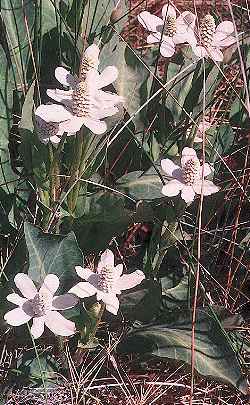Yerba Mansa, Lizard Tail
Scientific Name: Anemopsis californica (Nutt.) Hook. & Arn.
Family: Saururaceae

Anemopsis californica, photo © Gary A. Monroe. Ash Meadows National Wildlife Refuge, NV. May 23, 2002
USDA: 7-10
Sun Exposure: Shade to part sun
Origin: Southwestern USA, northern Mexico, marsh and creekside plant, 3000 to 4500 feet elevation (900-1350 m)
Growth Habits: Deciduous perennial, 12 to 18 inches tall (30-45 cm) ; thick aromatic rootstock; large, waxy, dull gray-green leaves, 2 to 8 inches long (5-20 cm), they turn red in autumn
Watering Needs: Prefers moist soils, tolerates salty and alkaline soils, tolerates occasional drought
Propagation: Seeds, rooted stolons, division in spring
The plant has been used medicinally. The leaves were used as a poultice to reduce swelling. The roots contain methyleugenol, an antispasmodic, and the dry root was chewed by the natives to relieve pain.
Blooming Habits:
The Yerba Mansa bears greenish to white flowers on a cone shaped spike, surrounded by 7 or 8 large petal-like bracts in summer, on 12 inches high stems (30 cm).
Desert-Tropicals is dedicated to provide gardening advice, gardening ideas, and information about flower of all kind for landscape and collections.We try to check carefully the identification of the plants on the illustrations as well as the other information from the page, but occasionally errors do occur. if you notice anything that needs to be changed please contact us.Thanks.
© 1998-2020 Philippe Faucon, All Rights Reserved.